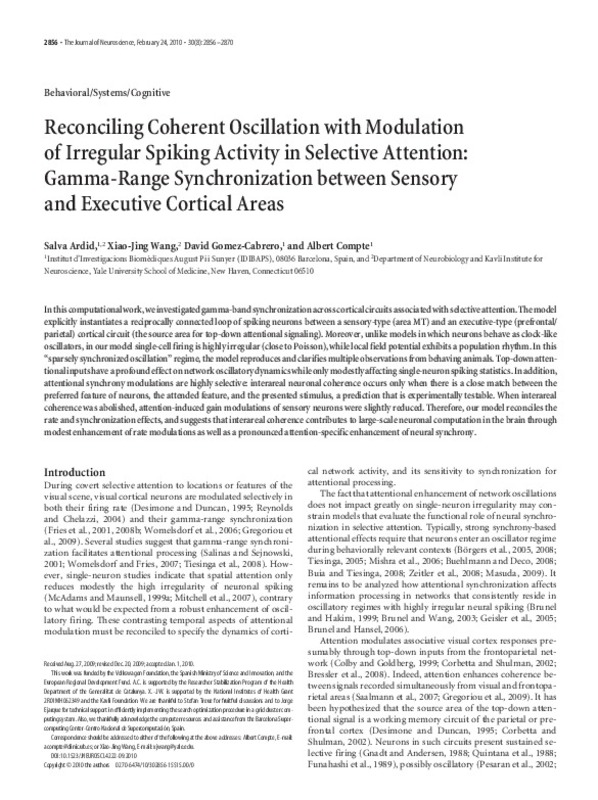JavaScript is disabled for your browser. Some features of this site may not work without it.
Buscar en RiuNet
Listar
Mi cuenta
Estadísticas
Ayuda RiuNet
Admin. UPV
Reconciling coherent oscillation with modulation of irregular spiking activity in selective attention: gamma-range synchronization between sensory and executive cortical areas
Mostrar el registro sencillo del ítem
Ficheros en el ítem
| dc.contributor.author | Ardid-Ramírez, Joan Salvador
|
es_ES |
| dc.contributor.author | Wang, Xiao-Jing
|
es_ES |
| dc.contributor.author | Gomez-Cabrero, D.
|
es_ES |
| dc.contributor.author | Compte, A.
|
es_ES |
| dc.date.accessioned | 2021-05-29T03:31:54Z | |
| dc.date.available | 2021-05-29T03:31:54Z | |
| dc.date.issued | 2010-02-24 | es_ES |
| dc.identifier.issn | 0270-6474 | es_ES |
| dc.identifier.uri | http://hdl.handle.net/10251/166956 | |
| dc.description.abstract | [EN] In this computational work, we investigated gamma-band synchronization across cortical circuits associated with selective attention. The model explicitly instantiates a reciprocally connected loop of spiking neurons between a sensory-type (area MT) and an executive-type (prefrontal/parietal) cortical circuit (the source area for top-down attentional signaling). Moreover, unlike models in which neurons behave as clock-like oscillators, in our model single-cell firing is highly irregular (close to Poisson), while local field potential exhibits a population rhythm. In this "sparsely synchronized oscillation" regime, the model reproduces and clarifies multiple observations from behaving animals. Top-down attentional inputs have a profound effect on network oscillatory dynamics while only modestly affecting single-neuron spiking statistics. In addition, attentional synchrony modulations are highly selective: interareal neuronal coherence occurs only when there is a close match between the preferred feature of neurons, the attended feature, and the presented stimulus, a prediction that is experimentally testable. When interareal coherence was abolished, attention-induced gain modulations of sensory neurons were slightly reduced. Therefore, our model reconciles the rate and synchronization effects, and suggests that interareal coherence contributes to large-scale neuronal computation in the brain through modest enhancement of rate modulations as well as a pronounced attention-specific enhancement of neural synchrony. | es_ES |
| dc.description.sponsorship | This work was funded by the Volkswagen Foundation, the Spanish Ministry of Science and Innovation, and the European Regional Development Fund. A.C. is supported by the Researcher Stabilization Program of the Health Department of the Generalitat de Catalunya. X.-J.W. is supported by the National Institutes of Health Grant 2R01MH062349 and the Kavli Foundation. We are thankful to Stefan Treue for fruitful discussions and to Jorge Ejarque for technical support in efficiently implementing the search optimization procedure in a grid cluster computing system. Also, we thankfully acknowledge the computer resources and assistance from the Barcelona Supercomputing Center-Centro Nacional de Supercomputación, Spain. | es_ES |
| dc.language | Inglés | es_ES |
| dc.publisher | Society for Neuroscience | es_ES |
| dc.relation.ispartof | Journal of Neuroscience | es_ES |
| dc.rights | Reconocimiento (by) | es_ES |
| dc.subject | Monkey Callithrix-Jacchus | es_ES |
| dc.subject | Fast network oscillations | es_ES |
| dc.subject | Visual-Cortex | es_ES |
| dc.subject | Working-Memory | es_ES |
| dc.subject | Neuronal synchronization | es_ES |
| dc.subject | Neural mechanisms | es_ES |
| dc.subject | Pyramidal neurons | es_ES |
| dc.subject | Parietal cortex | es_ES |
| dc.subject | Temporal integration | es_ES |
| dc.subject | Stimulus competition | es_ES |
| dc.subject.classification | FISICA APLICADA | es_ES |
| dc.title | Reconciling coherent oscillation with modulation of irregular spiking activity in selective attention: gamma-range synchronization between sensory and executive cortical areas | es_ES |
| dc.type | Artículo | es_ES |
| dc.identifier.doi | 10.1523/JNEUROSCI.4222-09.2010 | es_ES |
| dc.relation.projectID | info:eu-repo/grantAgreement/NIH//2R01MH062349/ | es_ES |
| dc.rights.accessRights | Abierto | es_ES |
| dc.contributor.affiliation | Universitat Politècnica de València. Instituto de Investigación para la Gestión Integral de Zonas Costeras - Institut d'Investigació per a la Gestió Integral de Zones Costaneres | es_ES |
| dc.description.bibliographicCitation | Ardid-Ramírez, JS.; Wang, X.; Gomez-Cabrero, D.; Compte, A. (2010). Reconciling coherent oscillation with modulation of irregular spiking activity in selective attention: gamma-range synchronization between sensory and executive cortical areas. Journal of Neuroscience. 30(8):2856-2870. https://doi.org/10.1523/JNEUROSCI.4222-09.2010 | es_ES |
| dc.description.accrualMethod | S | es_ES |
| dc.relation.publisherversion | https://doi.org/10.1523/JNEUROSCI.4222-09.2010 | es_ES |
| dc.description.upvformatpinicio | 2856 | es_ES |
| dc.description.upvformatpfin | 2870 | es_ES |
| dc.type.version | info:eu-repo/semantics/publishedVersion | es_ES |
| dc.description.volume | 30 | es_ES |
| dc.description.issue | 8 | es_ES |
| dc.identifier.pmid | 20181583 | es_ES |
| dc.identifier.pmcid | PMC2888157 | es_ES |
| dc.relation.pasarela | S\435002 | es_ES |
| dc.contributor.funder | Kavli Foundation | es_ES |
| dc.contributor.funder | Volkswagen Foundation | es_ES |
| dc.contributor.funder | Generalitat de Catalunya | es_ES |
| dc.contributor.funder | European Regional Development Fund | es_ES |
| dc.contributor.funder | Ministerio de Ciencia e Innovación | es_ES |
| dc.contributor.funder | National Institutes of Health, EEUU | es_ES |








